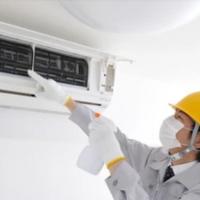How to Maintain your AC System in 3 Easy Steps
by Guest Post on Jun 1, 2019
The key to enjoying a continuously cool and energy-efficient home through the dog days of summer is to properly maintain your AC system. By performing some simple DIY maintenance, your air conditioner will run at peak efficiency for years to come, saving you money on your electric bill and on repair costs.
We’ve identified three easy ways to clean and maintain your AC system that can be done in little time and with a minimal DIY experience. We suggest, however, that you leave the more complex tasks to expert HVAC technicians. Below, you’ll find the maintenance jobs that are routinely performed by homeowners, resulting in fewer service calls and more comfortable homes.
1. Replace the AC System’s Air Filters
When it comes to your AC’s air filters, out of sight should never equal out of mind. That’s because dirty filters restrict airflow, putting unnecessary strain on your system’s motor. These blocked filters also result in decreased air quality and system performance that is less than optimal. So, regularly changing the air filter is one of the best (and easiest) ways to maintain your AC’s efficiency.
Changing the filters every 1-3 months is ideal to keep excess dirt and debris from coating the filters. Of course, homes with pets or lots of open windows and doors may require more frequent changes. At a minimum, you should replace air filters every 6 months, before the cooling season begins and as the season ends.
Keeping in mind that different types of systems require different air filters, be sure to verify your AC’s filter requirements prior to replacement. We suggest investing in suitable, higher-end filters to remove as many fine particulates as possible, providing cleaner air and increasing the system’s efficiency… all in one easy step.
2. Clear and Clean your AC’s Condenser Unit
An important, but often forgotten part of an AC system is the condenser unit. That’s because this key component is located outside the home. Responsible for converting the refrigerant vapor into liquid form, the condenser must be kept in good working order for more efficient cooling.
The AC condenser regularly vents hot air from the unit to the surrounding outdoor area, so it is essential that any dirt, debris, and plant material be kept clear of the unit. We suggest you maintain a clear area around the condenser unit of at least 2 feet in all directions. Doing this will reduce the risk of fire during the hot summer months, as well as avoid restricted air flow that could compromise your system’s efficiency.
As one of the more complex maintenance services you can perform, cleaning the AC condenser unit should only be done once you have read, and thoroughly understand, the following instructions. Otherwise, it is recommended that you contact a qualified AC technician.
- Turn off power to your AC condenser unit, both at the breaker box and at the outdoor unit’s shut-off box. CAUTION: Failure to do this may result in electrocution.
- Using a screwdriver or wrench, remove all fasteners from the base of the exterior fan cage, then remove the fan cage itself. Clean any visible debris from the fan cage by hand or using a wet or dry shop vacuum.
- Remove the outer cover from the condenser unit to access the exterior fins. We suggest using a powerful shop vacuum with a brush attachment to remove visible dirt. Then use a gentle spray from a garden hose to remove any remaining dirt or debris. NOTE: DO NOT use a pressure washer in this step—it will damage the fins. If you still see dirt on the exterior fins, use a fin-cleaning spray (found at most home improvement stores).
- Using a fin-straightening tool or butter knife, straighten any bent fins. CAUTION: Be careful not to damage the unit’s embedded tubing behind the fins.
- Locate and remove the interior evaporator coil door (you may need to use a wrench or screwdriver). Remove accumulated dust from the coil using a soft brush. Then, use a no-rinse cleaner to remove excess dirt from the coil. Let any remaining spray drip into the drain pan. Dump the collected spray from the drain pan, then use a mixture of hot water, soap and bleach to clean the pan. To protect against algae growth, we recommend using a drain pan tablet.
- If the bleach solution drains easily from the pan, skip this step.
- If the solution drains slowly or sluggishly, the drain tube is probably clogged. To clear the clog, remove the filter from a wet or dry shop vacuum. Create an air-tight space around the tube using duct tape or by holding a piece of cloth over the gap. Cover the tube with the vacuum hose and allow the suction power to clear the clog from the drain.
- Once the interior cleaning and maintenance are complete, replace the interior evaporator coil door, outer cover, and fan cage. Be sure that all screws and/or bolts are securely fastened.
- Make sure your condenser unit is level with the grounding pad. A unit that is not level with the pad will not perform at peak capacity and is prone to early failure. If you see that the unit is tipping to one side, use rot-resistant shims to level it.
NOTE:It is suggested that you cover the top of the unit during the winter months using a piece of plywood or a plastic cover**. This will keep debris from falling into the unit and make preseason prep easier AND prolong the life of the unit. DO NOT cover the sides of the unit as this can result in moisture buildup and corrosion.
**Note: Do not cover your condenser unit in the winter if it is a heat pump, as heat pumps run all year long. If you don’t know if your unit is a heat pump, consult the manufacturer or your retailer/dealer.
3. Check the Thermostat
To determine whether your system’s thermostat is in good working order, simply raise and lower the temperature setting until the AC turns off and on in response to the settings.
Get the most out of your AC this summer, while reducing your electric bills, by following your AC system’s service guidelines. We recommend only doing DIY maintenance on your home’s AC unit when you have thoroughly read all the information above and fully understand the instructions.
Popular Articles
Three Places to Spend Money on the Exterior of Your Home
When you have the exterior of your home remodeled, you are investing, time, energy and convenience into the project and you want to make sure that...
98561 Views
Homemade Headboards-Make an Upholstered or Wooden Headboard
Homemade headboards can add a lot of personality to any bedroom. They can be coordinated with existing furniture and room decor or they can be the...
75125 Views
When to Use a Brush, Roller or Sponge Brush
Brushes are a good choice for painting trim and woodwork. They are also useful for cutting in the edges around the top and bottom edges and corners...
72231 Views
Creating a Cottage Kitchen with Bead Board
Kitchen decor can range from modern and bold to elegant and elaborate by using strategic kitchen pieces. One of the most popular decorating trends...
53546 Views
Gas Fireplace Diagnostics and Troubleshooting
Follow these steps for diagnosing and troubleshooting Gas Fireplaces repairs. For the average DIYer, this may seem intimidating, depending on the...
30975 Views
Latest Articles
How Much Does It Cost To Take A Bath?
Plumbers know that a bath may seem like a relaxing luxury, but the real cost extends far beyond your water bill. The average soak uses 35 to 50...
on Apr 8, 2025
10 Concrete Patio Ideas on a Budget
A concrete patio can be a game-changer for your outdoor space. It is durable, versatile, and can be customized to fit your style. But what if you...
on Mar 25, 2025
Tips for Creating a Stunning Personalized Photo on Canvas
Order the unique beauty of a personalized photo on canvas and bring your memories to life. With a customized photo on canvas, you can transform...
on Mar 7, 2025
Best Areas to Buy Property in Singapore for Long-Term Growth
Singapore's real estate market remains one of the most stable and lucrative in the world. With limited land supply, strong governmental...
on Feb 18, 2025
Troubleshooting Excess Water in Your HVAC Secondary Condensate Drain Pan
When maintaining your air conditioning system, it is easy to overlook the condensate drain pan - until excess water starts pooling in places where...
on Jan 12, 2025
Featured Articles
What Type of Licensed Contractor Should You Hire?
on Feb 28, 2017
Hire Contractors / Estimates

Looking for a specialty project? There are many types of contractors available for your home improvement needs. Finding the right type of...
Sponsored Articles
Best Areas to Buy Property in Singapore for Long-Term Growth
on Feb 18, 2025
Real Estate / Finance

Singapore's real estate market remains one of the most stable and lucrative in the world. With limited land supply, strong governmental...
Actions
Top Categories
- Garden / Landscaping / Patio — 264
- Kitchen / Bathrooms — 240
- Real Estate / Finance — 203
- Appliance / Repair — 186
- Interior Design / Decor — 184
- HVAC / Air Conditioning — 148
- Cleaning / Maintenance — 144
- Improvements / Remodeling — 131
- Plumbing / Basements — 118
- Floors / Tile / Hardwood — 116
- Doors / Garages — 113
- Safety / Security — 113
Articles Archive
More DIY Articles
How to Open a Locked Bathroom Door from Outside
So you've found yourself locked out of the bathroom, unsure of how to proceed. Luckily, you've likely got all the tools you need to be out of this...
If Your AC Unit is Making Any of These Noises, Get It Checked Out
Air conditioners can and do make noises, and while some are completely normal and benign, others may signify a more substantial problem. If your...
5 Reasons to Let a Professional Plumber Handle That Plumbing Job
When it comes to home improvement, some homeowners swear by having a professional do it while others would rather opt for the DIY route. While...
What Should You Know About Moving A Piano? Can You Do It Alone?
It is quite difficult to move. A lot of stress adds up and moving furniture is definitely something that not everyone can do. When referring to...
When to Visit the Flooring Store: Repairing Existing Flooring vs. Installing New
Stylish flooring can transform a room. It’s the difference between a mediocre and a fancy home. The problem is that flooring tends to suffer more...

